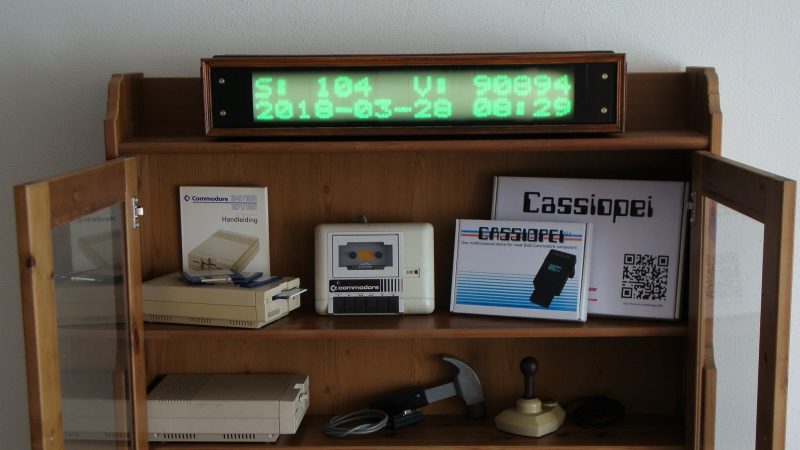Looking for an eye-catching and unique way to display the time and date? Want the flexibility to add other critical information, like the number of YouTube subs you’ve got? Care to be able to read it from half a block away, at least at night? Then this scrolling glow-in-the-dark dot-matrix display could be right up your alley.
Building on his previous Morse code transcriber using a similar display, [Jan Derogee] took the concept and went big. The idea is to cover a PVC pipe with phosphorescent tape and rotate it past a row of 100 UV LEDs. The LEDs are turned on as the glow-in-the-dark surface passes over them, charging up a row of spots. The display is built up to two rows of 16 characters by the time it rotates into view, and the effect seems to last for quite a while. An ESP8266 takes care of driving the display and fetching NTP time and YouTube stats.
We’ve seen “persistence of phosphorescence” clocks before, but not as good looking and legible as this one. We like the approach, and we can’t help but think of other uses for glow-in-the-dark displays.















Contrast on that picture. Old tech at the bottom, new at the top.
And the old, dot matrix display is a perfect accent to the old tech below.
Building starts around the two-minute mark.
…and then goes on to skip almost all of the build. His webpage is informative. Video isn’t.
Because the video focuses more about the need for this device rather then the build itself I can only agree. The video was mostly intended as light entertainment to introduce the project to the visitors of my project website. I’ll keep it in mind for my next project. Thanks for the tip.
I look forward to the next project!
It’s too bad that most of the build is skipped. This is the kind of project that got me into electronics – I would love some more detail on how he drove the cylinder, or at least a few more photos.
I hope this photo gives you a better idea. It really isn’t much, a rod, two bearings and a steppermotor with gear salvaged from an old matrix printer many many years ago.
http://home.kpn.nl/bderogee1980/projects/gitd_display/files/DSC03033_small.jpg
Seems like a horizontal belt would be another interesting approach. Depending on the speed it faded, you could have a continuous display.
A belt is indeed a very good idea. The visible text area will flatter improving readability, you could do with much less LED’s to light up the surface, although it does make writing a little bit slower, but for a continuous scrolling system that would not have to be a problem, perhaps even an advantage. Though the problem with a belt is that it is a bit more difficult to make (for me that is).
Nice display…
…thinking…
I can haz glow-VT100 plz?
The framerate might be a problem…
I remember some really long afterglowing green CRTs in the mid80s…
Ok…
Forget it…
But for some fracions of a second this was a nice idea…
You could use a UV laser and a couple of galvanometers… You could even make it like a “daisy wheel” printer, and have a photomask for each character that the (widened) beam projects through.
Check out Prysm’s Laser Phosphor Display, which uses spinning mirrors to raster scan UV lasers across a phosphor screen. It’s essentially a mechanical CRT.
Wow, those are brilliant (pun acknowledged)
https://www.prysm.com/solutions/laser-phosphor-display/
I wonder what the wired hammer is for?
the wired hammer is one of my other projects, the lighthammer it was posted on hackaday some time ago:
https://hackaday.com/?s=lighthammer
The lighthammer allows you to play “smack a mole” on a CRT with a C64 or a Simon-like clone game “hit the buttons”. Lot’s of fun, building instructions included, games are available for download including source code om my website.
http://home.kpn.nl/bderogee1980/projects/lighthammer/lighthammer.html
This is a good example of a double-buffered raster display, where the image is stored in a dynamic memory device that requires periodic external refresh.
I like his Pixel Beamer better. A digital projector using an old lo-res Nokia LCD screen and a big light bulb.
thanks, I build it in a time when 4K actually meant the whole screens number of pixels. Today 4K only means a row.
For those interested, more info here:
http://home.kpn.nl/bderogee1980/projects/beamer/4Kpixel_beamer.html
I would not use an incandescent bulb any more. LED or gas discharge.
I fully agree, the projector (which I made in 2006 and posted on my website since 2012) has been dismantled just a few years ago. Should I ever rebuild it, I would certainly use an LED. Much brighter, less heat and much smaller. The reduced heat would even eliminate the need for forced cooling. So if I ever build a new one, incandescent is not the way to go.